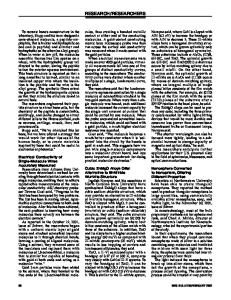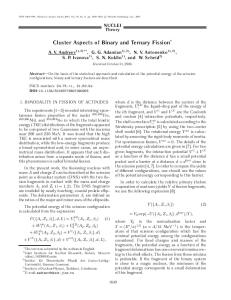Mixing Rocksalt and Wurtzite Structure Binary Nitrides to Form Novel Ternary Alloys: ScGaN and MnGaN
- PDF / 217,445 Bytes
- 6 Pages / 612 x 792 pts (letter) Page_size
- 48 Downloads / 281 Views
Z9.5.1
Mixing Rocksalt and Wurtzite Structure Binary Nitrides to Form Novel Ternary Alloys: ScGaN and MnGaN Costel Constantin, Hamad Al-Brithen, Muhammad B. Haider, David Ingram, and Arthur R. Smith Condensed Matter and Surface Science Program, Department of Physics and Astronomy Ohio University, Athens, OH 45701 ABSTRACT Combination of tetrahedral and octahedral based nitrides are explored. The two cases of MnGaN and ScGaN with low Mn and Sc fractions are examined. It is found that for the MnGaN case, the Mn is incorporated under N rich conditions with little lattice change. However, for the ScGaN case, the Sc is incorporated onto the Ga sites but with a local bond angle distortion. INTRODUCTION Only a select few special material systems present the opportunity for ideal lattice-matched epitaxy. It is therefore a great challenge to study materials, for example alloys, in which the separate binary materials are not isocrystalline. In this paper, we compare two such cases: 1) MnGaN; and 2) ScGaN. While GaN (bandgap 3.37 eV) has wurtzite structure and tetrahedral bonding, both MnN and ScN are face-centered tetragonal (fct) with octahedral bonding. Combining these disparate structures would appear to be quite difficult; yet, it is of significant interest to do so in order to form new materials having novel properties, including semiconducting, magnetic, and even ferroelectric. The two cases, MnGaN and ScGaN, are quite different in terms of both their interest and their growth. ScN is in fact a rocksalt semiconductor with a in the range 4.50−4.53 Å, an indirect bandgap from Γ → X of ~ 1eV, and a direct transition Et at the X point of 2.1-2.4 eV [1,2,3,4,5,6,7]. In principle the alloy ScGaN could have a bandgap in the range from 2.1-3.37 eV. In addition to having a widely varying bandgap, it is possible that ScGaN may also have widely varying electromechanical responses due to a transition from polar to non-polar structure with Sc concentration, as has been suggested by the recent local-density approximation (LDA) calculations of Farrer and Bellaiche[8]. Experimentally, Little & Kordesch grew ScGaN by sputtering and reported such a bandgap variation (from 2.0 to 3.5 eV); however, the structure was reported to be either amorphous or microcrystalline [9]. Therefore the structure of the alloy has remained unknown until now. MnN is a metal and has the fct structure with a = b = 4.22 Å and c = 4.12 Å [10]. One reason to combine GaN with MnN is for the possibility to form a room-temperature ferromagnetic MnGaN semiconductor [11]. Though challenging, growth of wurtzite MnGaN alloy by molecular beam epitaxy using radio frequency plasma has been reported [12,13,14]. In addition, cubic MnGaN has also recently been grown on GaAs (001) and found to have p-type conductivity[15]. The purpose of this paper is to make a structural comparison between ScGaN and MnGaN alloys mainly focusing on the low Sc (Mn) composition (x < 20%).
Z9.5.2
EXPERIMENTAL DETAILS In this paper, we present results from ScGaN and MnGaN alloys using a custom
Data Loading...










